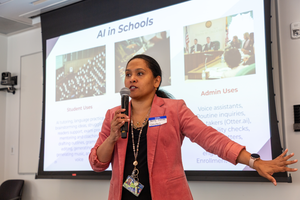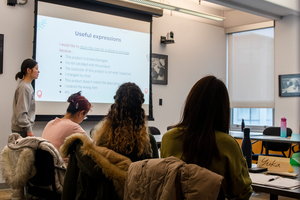Faculty Expert

The pandemic accelerated a troubling trend of rising absenteeism in K-12 schools. But by utilizing technology, establishing new practices and marshaling resources, school leaders can help get students to class — and keep them there.
When students miss a lot of school, it negatively impacts their learning and social skills. The ripple effects also interrupt learning for peers and put strains on teachers.
We're beginning the school year, so it’s a great time to think about resources and develop an action plan. In my research, I’ve identified three pathways that help reduce absenteeism:
- manage logistics
- establish routines
- build positive attitudes about school
Here are some ways to implement those in your own schools…
Create an engaging environment.
Small gestures go a long way. Children are more eager to attend school when they feel seen. One recommendation is to station staff by doors and greet kids by name, offering a friendly fist bump and good morning. For middle and high school students, starting the day with a homeroom or advisory period helps establish routines. By pairing students with someone they feel connected to, such as a Latinx homeroom advisor working with Latinx students, schools can help students build positive relationships.
Embrace technology.
With minimal investment, schools can deploy technology to counter absenteeism. For instance, a texting program is a simple and cost-effective way to communicate with caregivers and understand what might be amiss in school-going routines and logistics. When a student misses school, a staff member can check in and offer assistance, such as help with meals, clean clothes, transportation or healthcare. Most Americans have smartphones; texting is more effective and immediate than snail mail or emails.
Technology can also lend a hand when a student returns. If they’ve missed lessons, making up work can be a struggle. If a teacher needs to reteach material, it slows instruction for other students and can cause tension and anxiety. To help catch students up, you can share recordings of lessons or provide instructional videos. While these resources aren’t replacements for in-person instruction, they can be helpful tools.
Identify the pressure points.
When educators can identify a problem, they can offer the best support. Very often, logistical challenges at home, including food insecurity, lack of clean clothes or transportation barriers, correlate with missing school.
Since the pandemic, many schools provided students free breakfast and lunch, a critical resource. If there’s a way to make breakfast available in the classroom for all children, rather than in a cafeteria, that helps reduce stigma.
If a student needs clean clothes or personal hygiene items, a school can provide laundry service or supply wellness kits.
Finally, research shows that reliable, free transportation improves attendance. However, many school districts are reducing bus service due to driver shortages and budget cuts. Free access to public transit, carpools, and ridesharing can help if schools can't extend bus service.
Focus on transitions.
High absenteeism rates occur during "transition" years when children begin school or advance, including kindergarten, 5th grade, 9th grade and 12th grade. Students’ routines are interrupted, and they might lose access to support. This is stressful. To help, educators can offer these grades extra attention, including communicating schedules and school resources.
Some principals have even suggested rethinking the academic calendar and moving to year-round schooling to smooth transitions. By eliminating summer vacation and instituting regular breaks during the school year, districts could promote routines and relieve the burden of finding summer childcare.
It takes a village.
Teachers are on the frontlines of absenteeism, but they’re not alone. I encourage educators to activate their "ecosystem" and use all school resources to help. If a child is absent for illness, enlist the school nurse. If they're chronically absent because they need reliable transportation, principals could help.

Michael Gottfried is a professor at Penn GSE, where his research focuses on data-driven decision-making across a broad range of educational issues, including absenteeism. His most recent work is on understanding how new teachers are equipped to fight absenteeism and how providing free breakfast impacts school attendance. He also works directly with educators and school leaders to counter absenteeism.
Subscribe to the Educator's Playbook
Get the latest release of the Educator's Playbook delivered straight to your inbox.
Media Inquiries
Penn GSE Communications is here to help reporters connect with the education experts they need.







